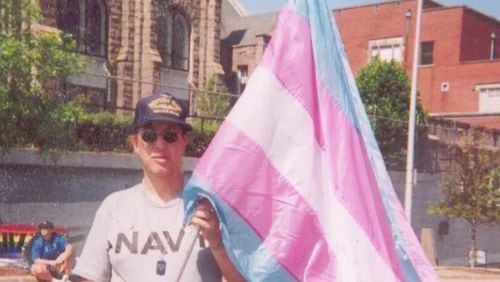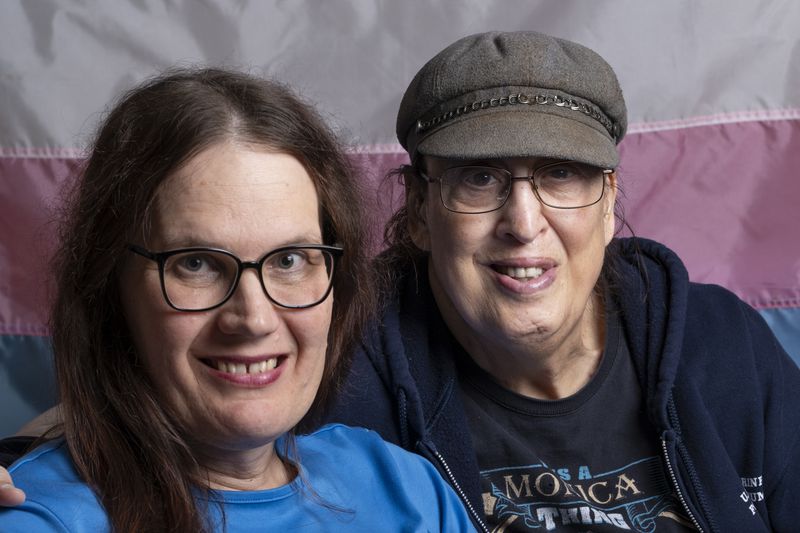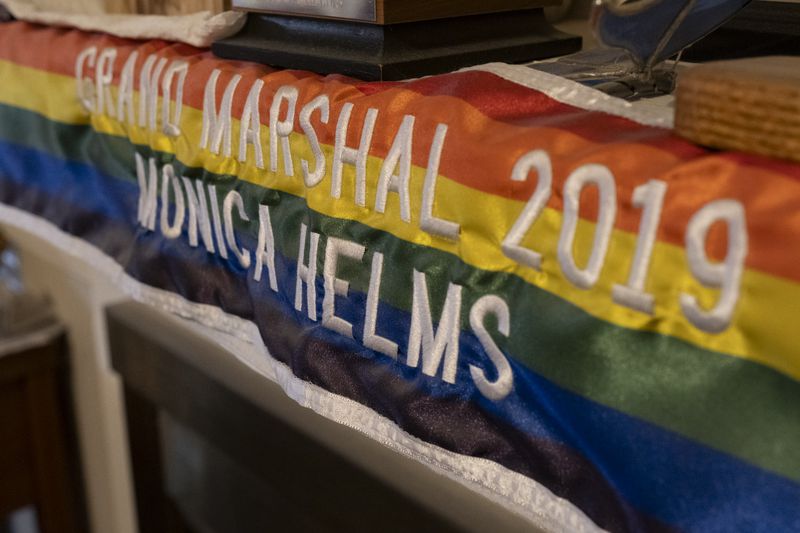Tucked on the couch of their cozy living room in Cobb County, Monica Helms and wife Darlene Wagner recount the story of how they met while contra dancing in the basement of a Unitarian church in North Druid Hills.
Behind them hangs the transgender pride flag. The simple blue, pink and white design was created by Helms in 1999 and can now be found on all seven continents and has its own emoji. It has been embraced as a universal symbol to transgender people that they are safe and welcome wherever it flies.
For many years, Helms, 72, and Wagner, 49, who are both transgender, felt that safety in Georgia. Now that’s changing: As trans Georgians face a wave of threats, from legislative restrictions on gender-affirming health care to a surge in rhetoric about “trans grooming,” the creator of the iconic symbol of transgender identity wonders if its message holds true in the place she calls home.
“I thought this house would be my forever home,” says Helms, who has marshalled Atlanta Pride and served as a Georgia delegate at the 2004 Democratic National Convention. “But it might be time to leave for a blue state.”
Credit: Ben Gray
Credit: Ben Gray
Making waves
Before Helms created the trans pride flag, she was an advocate for transgender veterans. Her military career began after high school, when she was still living her life as a man. It was 1970, and the Vietnam War was in full swing. Helms pulled a low draft number, meaning she’d likely be called up to serve. She enlisted in the Navy, figuring she’d have a smaller chance of seeing combat there than with the Army. “I really dodged a bullet,” she jokes.
Helms became a nuclear submarine machinist’s mate, serving on the USS Francis Scott Key and the USS Flasher. It was in the Navy, while stationed in South Carolina, that she began to explore dressing as a woman, a secret she kept from her all-male submarine crew.
“For a while I thought I was a heterosexual cross-dresser,” Helms recalls. After leaving the Navy, she fell in love, got married, and she and her wife had two sons. But meeting a transgender woman who was transitioning clarified Helms’ sense of herself. In 1987, she came out to her family and began her transition in 1992. It wasn’t easy: She and her wife eventually divorced, and Helms’ mother forbade her from seeing her father, who was ill with Alzheimer’s.
But for Helms, the chance to live an authentic life was worth the price.
“I remember praying to God at age 5 to turn me into a girl,” she recalls. “It took him 41 years, which I like to think is overnight delivery for the Catholic God.” She’s since reconciled with her family, including her mother, and Helms is close to her sons and four grandsons. “They’re the best things that ever happened in my life,” she says.
Her trans veteran advocacy work began almost by accident in 1997 when Helms attempted to rejoin the United States Submarine Veterans Inc. as a woman. The administrators balked. It wasn’t simply because she was transgender: At the time, women weren’t allowed on submarines at all, so no woman had joined the group — ever.
“They were a little confused, to say the least,” says Helms. She argued to administrators that she met all the requirements of membership — prior service on a Navy submarine and an honorable discharge. The group had no choice but to admit her, making her the first transgender person and the first woman to join. Since then, submarines have opened their doors to both women and LGBTQ+ servicemembers, and these days Helms knows dozens of transgender submarine veterans.
Helms continues to open doors for transgender veterans. In 2003, she co-founded the Transgender American Veterans Association, or TAVA, which advocates and fosters community for veterans who are transgender and gender non-conforming. When Helms and her cofounders learned that trans servicemembers were afraid to visit the Vietnam War memorial, TAVA organized a march to the wall. Dozens of transgender veterans showed up together to honor America’s fallen and lay a wreath at the tomb.
“There wasn’t a dry eye in the crowd,” Helms recalls.
Credit: Ben Gray
Credit: Ben Gray
Keep it simple
Helms’ work on behalf of transgender veterans brought her into LGBTQ+ activist circles, and in 1999, she found herself at a dinner seated next to Michael Page, creator of the bisexual pride flag. Page encouraged her to design one for the trans community.
“He told me to keep it simple because the least amount of sewing, the cheaper it is to make,” she recalls.
Two weeks later, Helms awoke with an idea; she drew it out with colored pencils and ordered a sample flag from the same company Page had used.
The design is as simple as it is poignant. “Light blue is a traditional color for baby boys, and pink for baby girls,” she explains. “The white in the center is for those who are transitioning or non-binary, or don’t feel they have any kind of gender.”
The flag is always right-side-up, a key element of Helms’ design: “No matter which way you fly it, it’s always correct,” she says. “It signifies us looking for correctness in our own lives.”
Helms began flying her new flag at marches and pride parades, conferences and funerals. When she left Phoenix and moved to Atlanta in 2000, taking a transfer with Sprint where she worked as a customer service agent, she brought her one-of-a-kind flag with her, marching in the color guard at the Atlanta Pride Parade.
Interest in her flag spread slowly. Whenever people asked her how to get one, Helms would direct them to the same flag maker to place a single order. But before long, the flag took on a life of its own. By 2013, the transgender flag was flying all over the world and was introduced to the emoji keyboard in 2020. In 2021, transgender mountaineer Erin Parisi planted the transgender pride flag on the highest peak in Antarctica. “I’m dedicating this to the resilience of the trans community,” Parisi wrote.
Helms donated her original flag to the Smithsonian Museum, where it remains in the permanent collection. Flags can’t generally be copyrighted, so she hasn’t profited off the proliferation of her design. But that was never the point, she says.
“It affirms transgender and gender-expansive people as a distinct, identifiable group,” she notes. “And when an oppressed or marginalized group begins to see itself and affirm itself, it will no longer tolerate being oppressed and marginalized.”
The transgender pride flag has become so ubiquitous that people are often surprised to learn that its creator lives in metro Atlanta. Helms recounts the story of its design in her 2019 self-published memoir, “More Than Just a Flag.”
Safety first
When Helms met her future wife, Darlene Wagner was at Georgia Tech completing a doctoral degree in bioinformatics, the study of using computer technology to collect, store and analyze biological data.
The native Georgian has had a colorful career, observing fisheries in the Bering Sea and studying birds of prey in Texas. She now works for the CDC in the viral disease division. Wagner came out as transgender in 2008 during her grad program.
“I’d heard horror stories about people getting fired from jobs for transitioning,” she says. “But I figured they probably couldn’t fire a grad student.” Her academic community was supportive, though at the time she was one of the only transgender people on campus.
Wagner and Helms married in 2016. They live in a leafy suburban cul de sac north of Atlanta, where geese, rabbits and the occasional coyote stroll by the house. They enjoy movie nights on the couch with their two cats, and Helms, who retired from Sprint a few years ago, has a basement workshop where she builds model rockets. It’s the life they always wanted, but as Georgia’s political climate grows more hostile to transgender people, Wagner and Helms have begun planning their exit.
“We’ll enjoy being out and proud for as long as we safely can, but we’re looking to sell the house and move to a blue state,” says Wagner, “which is hard because we really love it here.”
Transgender Americans have long been vulnerable to mistreatment, but the past few years have been marked by rising legislative and political opposition to the transgender community. According to the American Civil Liberties Union, conservative lawmakers across multiple states introduced more than 500 bills targeting LGBTQ+ people in 2023, many of them aimed at transgender Americans’ access to healthcare, public restrooms and school sports. Eighty-four became law.
Last year, Georgia passed a law banning most gender-affirming care for transgender minors, and the Georgia High School Association blocked transgender girls from playing on female high school sports teams. More laws targeting transgender Georgians are expected during the 2024 legislative session.
Wagner and Helms are concerned about the influence of neighboring Florida, which has passed some of the country’s most extreme laws restricting LGBTQ+ Americans. They are planning to adopt a child, and they fear policies like Florida’s “Don’t Say Gay” law restricting discussion of gender identity in public schools will make their way here. (A similar bill stalled in the Georgia legislature last year.)
“Not only do we want to be safe, we would want our children to be safe,” Helms says.
Leaving Georgia is a hard thing to contemplate for the transgender activist. “Atlanta is full of amazing LGBTQ+ people who have done incredible things,” she explains. “We love our community here, and we’ll miss our friends and family very much.”
But wherever she and Wagner go next, Helms will keep fighting for the rights of transgender veterans and for all trans Americans. For those they leave behind, Wagner has a message of hope: “Be strong, be resilient, be together,” she says. “Whatever they decide to throw at you, just survive, survive, survive.”
About the Author








